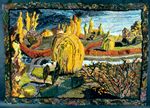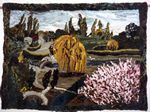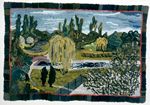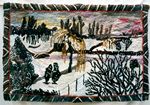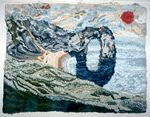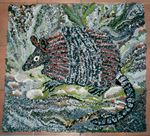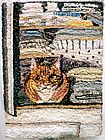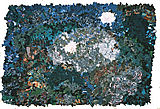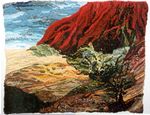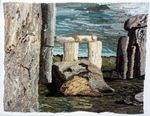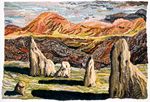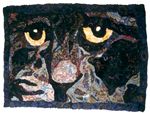![]()
by
Glenda Morris
When I think of Louisa’s rugs (really wall hangings), I think “painting”. She could take the easy way out and turn to painting or dyeing her own fabrics, but she prefers the thrill and the satisfaction of finding her materials in charity shops and car boot and jumble sales. It takes a certain imaginative eye and receptivity to turn last year’s fashions (and this year’s fashion mistakes) into Stonehenge in the Snow or Hunting Cat.
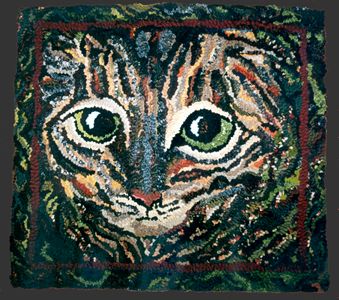 |
|
Hunting
Cat
|
She has the ability, so admired in the Italian masters, of giving the illusion of distance in her work. I dive into her rugs seeing at first only bits of velvet or a pattern that appeals and then, in exhibition spaces, step back 30 feet to find a three-dimensional landscape appearing with light and shadows or a cat with a distinctive personality.
Louisa has no formula, no way of working that guarantees a smooth process of development or an outcome that completely satisfies her (although I have never seen a “failure”). Some of her rugs have been easy to make from start to finish, others a struggle all the way. I have heard her tell people: “I do them in the evening while watching television”, conjuring up the image of someone who “cannot sit still but has to do something with her hands”. I protest against this picture. She works diligently, but light-heartedly, at her rugs.
Louisa does not consider herself a neat worker, but she does keep her fabrics tidy; arranging her palette (bundles of cut fabrics for the area she is working on) along the arm of the sofa, and from time to time stoping to view from a distance a newly completed part or ask if something “works”.
She encourages people to “just keep going” and follows her own advice. When she showed a half finished rug to her brother (an experienced painter and designer), I was relieved to hear him say that he could tell nothing about it at that stage. He echoed my feeling (and I have heard Louisa say this) that rugs, during construction, may seem unpromising, but in the end (maybe the very end) they do come together. A part that seems to be at odds with the rest can be the very thing that eventually makes the rug.
Louisa remarks how odd it is that she, who is very short sighted, is fascinated by landscapes, and this fascination shows in the transformation of rags into Rowntree Park (one rug for each of the four seasons), Durdle Door (both calm and stormy) and stone circles (views of Stonehenge, Avebury and Castlerigg). She is always observing, drinking in impressions, noticing colour and form and the play of light and shadow; and she thrills to landscapes no matter how bad the weather. (She accused me of being a wimp because I refused to clamber with her over Pulpit Rock, Portland Bill, during a howling winter gale!)
I have not, however, refused to go roaming through the charity-shops with her to find grey evening-wear that glinted like rain-soaked rocks or animal prints to serve as woodland in the sun. She is constantly building up her inventory; although living in a small terraced house, she has had to sacrifice the “non-essentials” (like ordinary clothes) to store her fabrics in the chest of drawers. She will wear her inventory until she needs it in a rug.
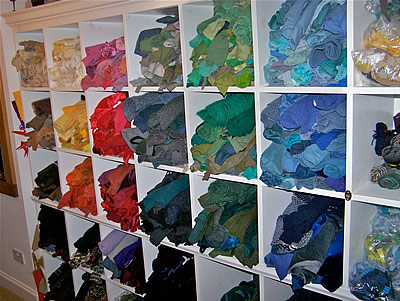
Lewis and Louisa's ragstore
Rather than using whatever comes to hand, she thinks about the effect she wants. One time she was about to cut up a duvet cover with a small blue and white angular pattern. One of her friends protested at her cutting up a perfectly good cover and took it away for her son to use. After trying all evening to find something suitable, Louisa decided that art could not be compromised and asked for it back. The happy part of the story is that the person had come to the same conclusion, and the choppy sea in Cornish Headland is now in the Senior Common Room of the University of York.
So this is another part of Louisa's secret: she is not afraid to be discriminating and what some people would call extravagant with fabric (all recycled). She is generous with her materials, and rarely says things like "That ginger cat-colour jersey brings out the purple in your complexion, but I could use a sleeve in Rosie’s Second Cousin", but such has been known to happen. And this is another part of the secret of her work: her sense of play and delight in the fabrics. She never uses glitter to get sparkle in her rugs; the liveliness comes from the use of unexpected colours. For example, the black fur in Mouse-Eye-View is not black, but a combination of many shades and colours.

Rosie's
Second Cousin
2001
Armadillo is a good example of Louisa’s creative use of fabric. She was the executrix of her mother’s cousin, Deenagh's, estate. Deenagh had many clothes, mostly patterned, and as she had a soft spot for armadillos (don't we all?), Louisa created a wall hanging from the clothes in memory of Deenagh. What in other hands might have become a hotchpotch of conflicting fabrics screaming for attention is, from her hands, harmonious.
So how does she go about making a rug, and how did she come to make rugs in the first place? About 15 years ago, she saw a rag rug in a museum and wondered why people were no longer making them. She took a piece of upholstery hessian and a latchet-hook, and cut up some strips of cotton to make her first rugs, gradually finding the right hessian, hook and fabrics.
To finish the edges, she hems the hessian before she begins and works to the very edge. To hang the rugs, she sews the smooth part of a strip of velcro on the back of the rug and then glues and nails the rough velcro to a batten, adding screw-eyes at the top and hanging them with picture hooks or “S” hooks. This allows them to be hung in a variety of places without damaging them. She hangs each newly completed rug in her living room so that she can get to know it; as well as to provide a changing exhibition for her guests.
Click on the images
to see a larger picture
Louisa’s first and best-known rug is Rosie in the Airing Cupboard. So legendary is this rug that someone, upon seeing it at an exhibition, peevishly asked me why Louisa did not do her own designs rather than copying from books. After conducting a recent workshop, Louisa commented that Rosie is a very appealing subject, but demonstrates none of the elements that she now advocates: a free and non-literal design; the use of a wide range of fabrics, including woollens; and many closely related shades.
Louisa has not spent much time experimenting with different techniques, but from time to time she feels the need for a complete change. These occasional experiments influence her later work. For example, she has made two clippies, Owl and Balmy Night. The later is a large, shaggy, abstract rug and, although the result pleases her, it is so large and heavy that she has had to have a special frame made to display it. She never, by the way, uses a frame to work on – not even on the clippies – as she finds frames cumbersome.
After that, she experimented with abstract design in Flute Player, an appropriate subject for her as she is a professional flautist. The shepherd is playing while tending his flock, and the sheep in the foreground are suggested, rather than boldly drawn.
People sometimes ask where she gets her inspiration and how she goes about the designing of her rugs. Inspiration comes from many sources, including nature and photographs, but the designs are her own, especially of her cats. She says her head is full of cats; many of them (in her mind) related to a beloved cat, Rosie. Some of her designs are images from childhood – Durdle Door and Stonehenge – or familiar places like her brother’s thatched cottage (13 Boveridge and 13 Boveridge in the Snow), or even a cherished Silver Jug. In addition, she travels widely: Ayers Rock and Lizard of Oz come from her Australia trip and Volcanic Craters from New Zealand.
The way she goes about designing rugs has changed during the making of more than 70 rugs. At first she had little confidence in her ability to draw, so she made sketches and transposed them to the hessian by squaring up the design. Now she sketches out her designs on paper and draws bold lines with a felt tip-pen straight onto the hessian, without recourse to mathematical squaring-up.
In working the rug, she begins with the most important feature – such as the eyes of the cat or the sun in a winter landscape – and then goes on with a section at a time – the sky, or a rock, or a tree. If she is doing a border, it is usually done last.
Louisa prefers to make large rugs (approx. 5’x4’) so that she can thoroughly explore a subject and break off to work on smaller projects such as tea or coffee-cosies, mats, cushion-covers or small rugs. Because large rugs are so heavy to work on and difficult to display, she has turned to making smaller (approx. 3'x3') rugs: Tree Seasons (four rugs) and Avebury Impressions, a expaning series, are two examples.
Louisa if often invited to give workshops. Although teaching is not new to her (she has been teaching people how to play the flute all of her adult life), she remarked that teaching about rug making is different. In playing an instrument, a fairly standard technique must be learned, whereas in rug making there are no rules. She believes in inspiring people, in bringing something out of them rather than putting something in. Some measure of her success in inspiring unique work from her pupils is that both her husband, Lewis, and I have developed our work in entirely different directions.
Louisa is not interested in making a profit from her work. She reluctantly parts with her rugs, charges for workshops and cards, and has a website (www.louisa-creed-ragrugs.co.uk); however, she makes rugs and teaches because she enjoys creative activity and cannot help but inspire others to do the same.
©
Glenda Morris 2003
If you would like to reproduce this article please contact Glenda at gbmorris@btopenworld.com
Click on the images
to see a larger picture
Also
see
Listen to Your Rugs: Louisa Creed's Approach to Rag Rug Hooking,
first published in Rug Hooking magazine.
RUGS
:: LOUISA &
RAG RUGS :: LEWIS & RAG RUGS :: CONTACT
CREDITS & LINKS :: HOME
Louisa
Creed
York, UK, 2001-2024
